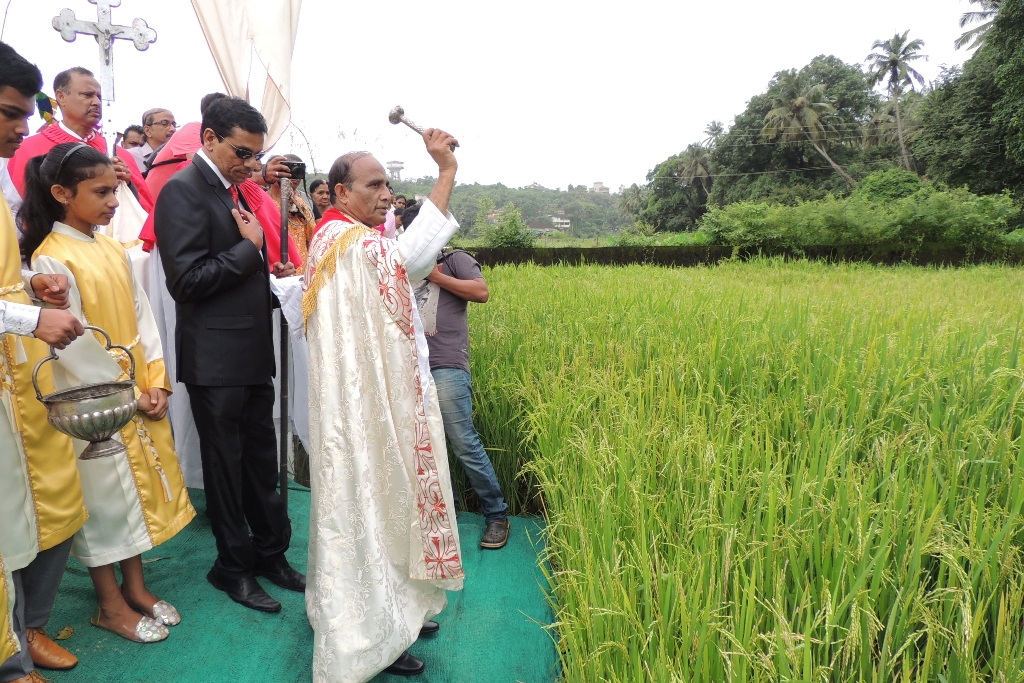
One of the traditional occupations of Goans has been agriculture since time immemorial. After a heavy downpour in June-July, the fields slowly show up the first sheaves of paddy- the fruits of the farmer’s hard work. Before harvesting, it has been a tradition to offer the first fruits to the Almighty in a Thanksgiving ritual and cultural events.
In the Scripture, Cain and Abel, the offspring of Adam and Eve, brought offerings of their labour to the Lord (Gen. 4:3-8). The custom of harvesting the first paddy sheaves and offering them to the Lord is called Novidade or Fiesta da Espiga in Portuguese or Konnsanchem fest in Konkani.
The thanksgiving celebrations began sometime in 1837, when the Reverend Robert Stephen Hawker invited his parishioners to a unique harvest thanksgiving service at the church in Morwenstow, Cornwall, UK, in 1843.
How Taleigao got the privilege
for Novidade on August 21? (subhead)
Portugal was keen to establish sea routes to Asia for the spice trade. The Ottoman Turks monopolized the traditional route through the Red Sea and the Gulf. King Manuel-I deputed Admiral Afonso de Albuquerque to conquer Ormus, Aden, and Malacca, assume active control over all the main maritime trade routes of the East, and establish colonies.
At that time, Goa was under the control of Ismail Adil Shah of Bijapur. The rule was oppressive to the Hindu population, who were taxed heavily, making their life miserable. So Hindu chiefs of Goa petitioned Timaya Nayak, a powerful and influential Hindu exiled from Goa and then the Admiral of the Honavar fleet, about their exploitation by the Muslim rulers. They pledged their support to Timaya if he agreed to assist them in changing the situation.
Timaya invited Albuquerque and his captains to conquer Goa. Albuquerque's fleet launched an attack from the River Mandovi on the Adil Shah palace in March 1510 but was pushed back by 60,000 Muslim men. Albuquerque immediately left Mandovi to get more troops, leaving behind his fleet. The Portuguese troops were stranded on rafters at Penha-de-França because the navigational channel was blocked by a sand bar at Aguada.
With provisions running out, the troops had to survive on mice. The fishermen of Taleigao saw their plight and informed the ganvkars, who quickly arranged food grains. Taleigao was the granary of Tiswadi, as most fields were cultivated. They carried provisions in canoes in the dead of the night, risking their lives from Muslim soldiers and bad weather.
Albuquerque returned with a more extensive fleet and captured Ilhas on November 25, 1510. Good deeds are rewarded. Adm Albuquerque granted the ganvkars of Taleigao three privileges at their request: to cut paddy sheaves on August 21, three days before the rest of the Tiswadi villages, to carry the Portuguese flag during the harvest celebration, and to present the first sheaves to the Governor.
Rituals of the 4-day Novidade (subhead)
Festa da Espiga or Novidade is the only harvest festivities that are celebrated for four days at Taleigao by the ganvkars of the first group, on a rotation basis, starting with Mendonça, Viegas, Martins, Luis, Gomes, Faria, Almeida, Falcão, and Abreu. These details have been published in Chapter 54 of Afonso Mexia's Foral de Usos e Constumes, dated September 16, 1526.
The announcement of the feast to the surrounding villages begins with the firing of cannons on August 20 at noon. At the dawn of August 21, a brass band – Alvorada– plays festive tunes in village by-lanes, putting the villagers in a festive mood. The feast president marches to the St Michael Church under a ceremonial umbrella, accompanied by dhol-caxia, trumpet, and cannon firing at the church square.
The congregation moves in a procession to the designated field at Tolleant, with Confrades carrying the statue of St Michael on a charol. The priest venerates the field, and the feast President cuts the sheaves with a silver sickle takes them on a silver plate, and the procession returns to the church. The procession stops by the St Michael’s chapel at Bodiem for offering some sheaves, followed by a short prayer. The procession returns to the church, where a solemn mass is celebrated. The sheaves and other items like agriculture tools are offered to the Almighty.
On August 22, the feast president set out under cover of a ceremonial umbrella and accompanied by the beating of dhol-caxia and sounding of the trumpet and cannon firing distributes fov (beaten rice) to ganvkar families in the village. This is a ritual to share the joy and happiness of the Novidade with fellow ganvkars.
A ceremonial plate of fov is also offered to the parish priest at the parochial house on August 23, as a gesture of gratitude to the pastor for his selfless community service and nurturing it with God's Word.
August 24 is the grand finale of the four-day festival. A group of representatives from nine ganvkars and three from the managing committee carries fov and a paddy stalk to the Se Cathedral, which was the seat of the Patriarch of the East Indies till 1843. The parish priest receives the delegation and the golden bell is rung. A mass is celebrated, which is attended by devotees from the villages around Old Goa.
After the Mass, fov is distributed to the congregation and the canons of the Se Cathedral chapter. The delegation visits the Archbishop's house in Altinho and presents him with fov. They make one final stop at the Raj Bhavan in Cabo, where they interact with the Governor and offer fov. A buffet featuring at least 12 traditional dishes, including fov blended with jaggery and grated coconut, is served to the delegation at the feast president’s house.